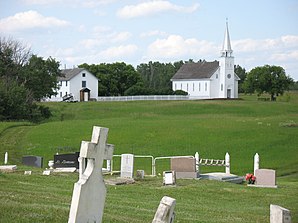Batoche
| Batoche | ||
|---|---|---|
 View from the cemetery to the rectory and the church |
||
| Location in Saskatchewan | ||
|
|
||
| State : |
|
|
| Province : | Saskatchewan | |
| Region: | Census Division No. 15th | |
| Rural municipality: | St. Louis No. 431 | |
| Coordinates : | 52 ° 45 ′ N , 106 ° 7 ′ W | |
| Height : | 480 m | |
| Time zone : | Central Time ( UTC − 6 ) | |
| Postal code : | S0J 1E0 | |
| Area code : | +1 306 | |
Batoche is a hamlet ( Hamlet ) and electoral district in the Canadian province of Saskatchewan on the banks of the South Saskatchewan River about 70 km northeast of Saskatoon . Founded in 1872, it soon became one of the largest Métis settlements and was the seat of the Métis Provisional Government of Saskatchewan during the Northwest Rebellion in 1885, and most recently the scene of the decisive Battle of Batoche . From 1888 to the founding of Saskatchewan in 1905, Batoche was an electoral district within the Northwest Territories, which at that time still comprised most of Canada .
history
The Batoche settlement, built by the Métis , was founded in 1872. It is named after the merchant and cattle breeder Xavier Letendre dit Batoche, who was the founder of the place and who lived there himself. Letendre built a trading post in the mid-1870s and planned an extensive trading network that extended to Fort-à-la-Corne in the northeast and Frog Lake in the northwest. He held other posts in both villages. Letendre mainly traded in furs, which he bought from the Cree Indians and exchanged for other goods.
The Métis settlers lived mainly from agriculture and animal husbandry. By 1885 the population rose to up to 500 people. During this period Batoche owned several shops, a rectory and a Roman Catholic church. Letendre himself commissioned it and later gave it the name St. Antoine de Padoue. In the late 1880s, Batoche was declared the de facto capital of Riel's Provisional Government of Saskatchewan , which included the area.
The Battle of Batoche began on May 9, 1885. General Frederick Middleton rode to Batoche that morning, having camped near the settlement for some time. Middleton was supported by other advancing troops and a new Gatling cannon brought by steamboat. However, due to a sudden loss of conscience, he initially refused to take the city. On May 12, several teams finally penetrated to the outskirts of Batoche and began bombarding the Métis lines until they finally ran out of ammunition. The fur trader and Métis leader Gabriel Dumont then fled into exile in Montana; Louis Riel , who refused to make this decision, surrendered three days later.
National Historic Site of Canada
Batoche was officially named a National Historic Site in 1923 . The visitor center, built later, offers multimedia presentations and provides insights into the history and life of the residents at that time. In addition, several of the buildings built when it was founded and rebuilt after the battle were restored and converted into a small open-air museum, which show the life of the Métis between the years 1860 and 1900. The site of the museum now includes an NWMP camp, several farmhouses, the rectory and the St. Antoine de Padoue church. The complex is open almost all year round from mid-May to mid-September.


